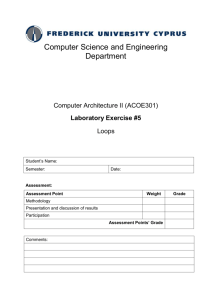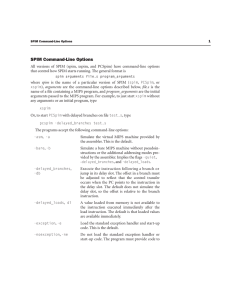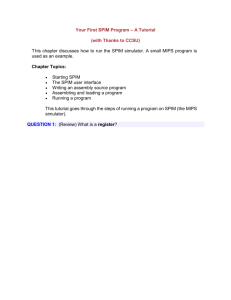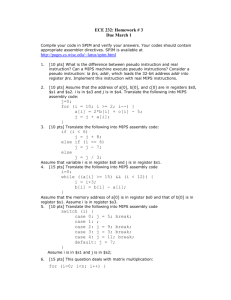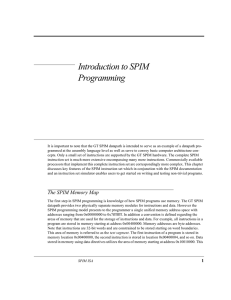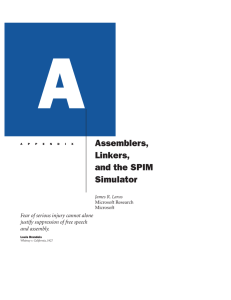lab2
advertisement
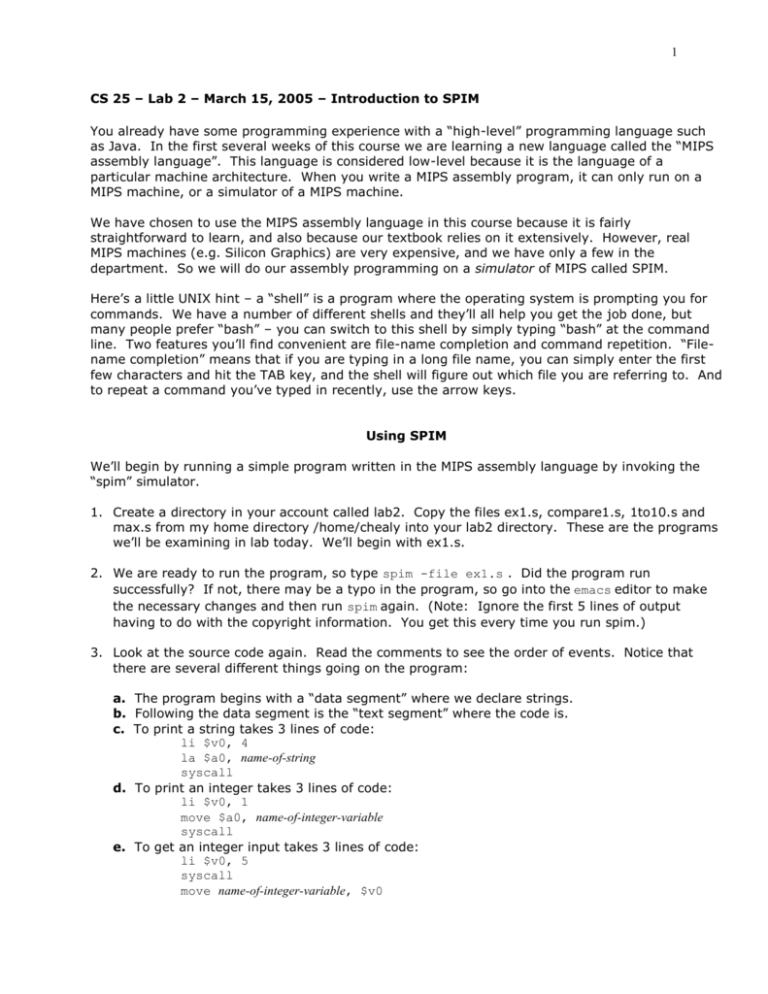
1 CS 25 – Lab 2 – March 15, 2005 – Introduction to SPIM You already have some programming experience with a “high-level” programming language such as Java. In the first several weeks of this course we are learning a new language called the “MIPS assembly language”. This language is considered low-level because it is the language of a particular machine architecture. When you write a MIPS assembly program, it can only run on a MIPS machine, or a simulator of a MIPS machine. We have chosen to use the MIPS assembly language in this course because it is fairly straightforward to learn, and also because our textbook relies on it extensively. However, real MIPS machines (e.g. Silicon Graphics) are very expensive, and we have only a few in the department. So we will do our assembly programming on a simulator of MIPS called SPIM. Here’s a little UNIX hint – a “shell” is a program where the operating system is prompting you for commands. We have a number of different shells and they’ll all help you get the job done, but many people prefer “bash” – you can switch to this shell by simply typing “bash” at the command line. Two features you’ll find convenient are file-name completion and command repetition. “Filename completion” means that if you are typing in a long file name, you can simply enter the first few characters and hit the TAB key, and the shell will figure out which file you are referring to. And to repeat a command you’ve typed in recently, use the arrow keys. Using SPIM We’ll begin by running a simple program written in the MIPS assembly language by invoking the “spim” simulator. 1. Create a directory in your account called lab2. Copy the files ex1.s, compare1.s, 1to10.s and max.s from my home directory /home/chealy into your lab2 directory. These are the programs we’ll be examining in lab today. We’ll begin with ex1.s. 2. We are ready to run the program, so type spim -file ex1.s . Did the program run successfully? If not, there may be a typo in the program, so go into the emacs editor to make the necessary changes and then run spim again. (Note: Ignore the first 5 lines of output having to do with the copyright information. You get this every time you run spim.) 3. Look at the source code again. Read the comments to see the order of events. Notice that there are several different things going on the program: a. The program begins with a “data segment” where we declare strings. b. Following the data segment is the “text segment” where the code is. c. To print a string takes 3 lines of code: li $v0, 4 la $a0, name-of-string syscall d. To print an integer takes 3 lines of code: li $v0, 1 move $a0, name-of-integer-variable syscall e. To get an integer input takes 3 lines of code: li $v0, 5 syscall move name-of-integer-variable, $v0 2 f. To exit the program takes 2 lines of code: li $v0, 10 syscall g. The names of our integer variables are always 3 characters: a dollar sign, a letter, and then a digit. But the names of our string variables that we declare at the top in the data segment can be basically anything we wish. 4. Run the program again. Notice that the sum is being printed with no introduction. For instance, if the inputs are 7 and 8, the output is 15, but there is no nice sentence saying “The sum of the two numbers is ” preceding the 15. How could the program be changed to include this string in the output? Our approach would be just as in a high-level language: we would need to declare a new string, and then in the program itself use this string. Look at how the original version ex1.s program handled string output, and mimic that. √ Control Structures and Comparisons Control structures are ways that a program can make choices or do something more than once. In a high-level language, we usually make choices using if statements. Doing something more than once entails a loop. In this lab, we will begin to explore these types of control structures as they appear in the MIPS assembly language. You have seen the 6 kinds of branch instructions – beq, bne, blt, ble, bgt and bge. Since comparing to the value 0 is so common, the MIPS assembly language includes two instructions, beqz and bnez, that allow us to perform comparisons against zero. For example, the syntax for beqz is: beqz register, label The meaning of this instruction is “If the register is equal to zero, then go to the instruction immediately following the label. Otherwise, just continue on to the next instruction following the beqz.” 1. You may find it convenient to see this program on paper. We can use the lp command to print it out. Type “lp –o nobanner compare1.s”. 2. Study the program compare1.s. Write down what you expect it should do. 3. Run the program with the SPIM simulator: “spim –file compare1.s”. Do you understand the output? You should notice that there is a logical error (bug) in the program. Read the source code again, and compare it to the comments along side. Note: If you reach the bottom of your telnet window, it may become very difficult to see the output of your program. If this happens, type the command clear to clear the screen, and run your program again. 3 4. When debugging a program, it is often useful to step through the code to see what is happening with each instruction. SPIM has this debugging feature. At the command prompt type in “spim” with no arguments. Once in spim, you will see a special prompt “(spim)” at the beginning of the line. Here is where you type in commands for the simulator itself. Incidentally, you can find a list of all these commands on the textbook CD under Tutorials SPIM tutorial Getting started with spim. 5. We want to load the program compare1.s into the simulator, so type load “compare1.s” at the spim prompt. Now we want to step through the code one instruction at a time. Note: this can typically be a slow and tedious process. If you get lost, call me over. Fortunately, this program is quite short and it won’t take long. Type the command “step” and hit return. It is also sufficient to use “s” as a command shortcut since “step” is the only command beginning with the letter s. The first six instructions that the simulator executes are actually preliminary to your program so we can skip through these. In spim, you can simply hit return to repeat the same command. So, if you hit return several times now, you will be stepping through instructions without having to type the word “step” or “s” each time. 6. As you step through instructions, you will see various information presented to you about each instruction, for instance here is the 2nd instruction in the program: [0x00400024] 0x3c041001 lui $4, 4097 [prompt] ; 16: la $a0, prompt There are 4 pieces of information here, namely a. b. c. d. the the the the address of the instruction hexadecimal encoding of the instruction assembly instruction as the hardware sees it assembly instruction as it appears in the program (16 is the line number) You should pay close attention to the last column, because this is literally the instruction that appeared in the program, including the comment off to the side. One thing that makes debugging a little more difficult is that when you step through instructions, you are actually stepping through the hardware-oriented instructions: note the distinction between c and d in the above list. An assembler’s job is to convert our assembly code into machine code, but along the way, the assembly instruction may be changed to facilitate the translation process. One reason why an assembly instruction would need to be changed would be if the instruction type didn’t really exist in hardware. For example, notice that the first “li” instruction has been changed into an “ori” instruction that essentially does the same thing. 7. At some point you will see the simulator say Please enter an integer: (spim) The part that says “Please enter an integer:” is the result of an output operation that has just occurred. But notice that there is a spim prompt here, so we still hit return to go on to execute the next instruction, which is the “li $v0, 5”. When you step through the next syscall instruction, notice that the cursor is now at the beginning of the line, with no “(spim)” prompt. This is actually the prompt from your program, so now you give a number and hit enter. 4 8. Step through the next instruction, which is “move $s1, $v0”. Now we will ask spim to tell us what value is contained in register $s1, by using spim’s print command. Type “print $s1”, and you should see the same value that you just entered. This value is given to you in both hex and decimal formats. Now you can step through the rest of the program, until you get to the part that has the bug. Watch the order of instructions carefully. Sometimes the control flow jumps around when we use branch/jump instructions like beqz. 9. Once you have diagnosed the problem, make the necessary modification(s) so that the program will work properly. 10. Modify the program so that it uses the bnez instruction instead of the beqz instruction. bnez stands for “branch if not equal to zero”. Call this new version of the program compare1a.s. Don’t change the effect of the program. √ Using a Loop Once we understand how to write branch and jump instructions, it is rather easy to write loops. All that we need to do is branch or jump backwards in the code in order to repeat something. 1. Look at the program 1to10.s. This is the same program that I gave out in class, which prints the numbers 1 through 10 on the screen. Before going on, you should understand the role of the bgt and j instructions that appear near the beginning and end of the loop, respectively. 2. We can modify the program to make it more useful. Copy this program into a new file called range.s. Enhance this program so that instead of always printing 1-10, it does the following: a. Asks the user to enter two integers. (Mimic the code for inputting integers that you saw earlier in the lab today.) b. Prints all integers in the range from the first integer up to the second integer. But if the first number is greater than the second, it will print nothing and quit. For example, if the user enters 4 and 7, then the program should print 4 5 6 7 and then quit. 3. How would you change your program so that it will count backwards in case the first number is bigger than the second? In other words, the program should count from the first number to the second number no matter which direction it happens to be. (4, 7) gives 4,5,6,7 and (7, 4) gives 7,6,5,4. Give it a try. √ 5 Max and Min of an Array I will probably need to work with you on this part because we have not had much experience with arrays yet. The key idea is this: to get a number from an array, you need to know its address. If you need to go through all the elements of an array, this address starts out at the array’s starting (base) address, and needs to increment on each iteration of the loop. The array is everyone’s favorite data structure. Today we experiment how to access array elements in the MIPS assembly language. Recall that when we have an array of integers the instructions we commonly use are lw (load word – for loading a number from an array into a register) and sw (store word – for putting a register value in an array). In this section, we perform a useful array operation: finding the maximum and minimum element. 1. The program max.s finds the maximum element in an array. Print a hard copy of the program (lp –o nobanner max.s), and run it (spim –file max.s) so you see what happens. You should be able to recognize the loop, and the comparison being performed on each iteration. 2. The program should output “The largest number in the array is 48”. It would be nice if there were a period at the end of the sentence. Add the code necessary to accomplish this. 3. Now, a more interesting modification. Suppose that we were not just interested in the value of the largest element, but where in the array this largest element is. It turns out that the value 48 is at position 5 (which is the 6th element) in the array: array[5] is 48. Change the program so that it will keep track of the index value where the largest entry exists. This may entail using another register, such as $s6. And then at the end of the program, print this index out as well. 4. If we can find the max, then we also know how to find the min. Adapt the max program so that it also performs the analogous process of finding the smallest element of the array, and also its position within the array. You can test your program by changing how the element values are initialized, such as turning –39 into positive 39 so that the smallest element will now be –23. √ You’re done! Now, to log out of a telnet/putty session, type exit and close the telnet window. I realize that you have a lot here to digest: a new operating system and a new programming language, and then modifying programs in this language. Please don’t hesitate to ask me questions if you have difficulty figuring out what to do.
